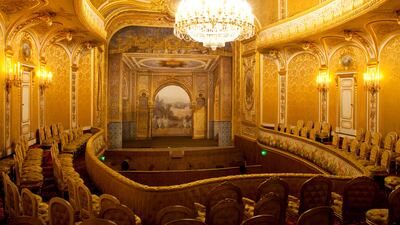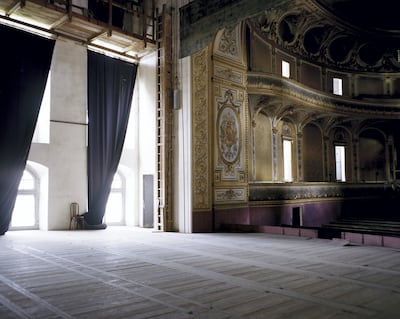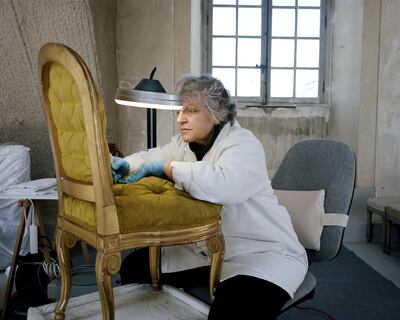At the end of September, a team from the Louvre Abu Dhabi took to a stage in the Louvre Museum in Paris to brief the French press about the opening of the Saadiyat Island museum at a crucial moment in its preparation.
Just the day before, Jean-François Charnier, the scientific director of Agence France Muséums, had been supervising the installation of one of the many masterpieces that will feature in the new museum, Francesco Primaticcio's Apollo Belvedere, a loan from one of 13 French institutions that are providing the Louvre Abu Dhabi with objects, the Palace of Fontainebleau.
A royal residence that sits in the heart of a vast forest, almost 60 kilometres south-east of Paris, Fontainebleau started out as a 12th-century hunting lodge, which was transformed into a palace in the 16th century and became associated with every French ruler – king, queen, empress and emperor – for almost 800 years.
One of several bronze statues created for the French king Francois I in the early 1540s, Primaticcio's Apollo was a copy of a Roman marble statue that was installed in the sculpture court of the Belvedere of the Vatican Palace by Pope Julius II, a move that helped to make it one of the most admired statues to have survived from classical antiquity.
Since the 1960s, Primaticcio's bronzes have been installed in the Palace of Fontainebleau's Galerie des Cerfs, a room decorated with bird's-eye-view paintings of royal palaces and their hunting grounds and plaster casts of stags' heads, but now that the Apollo Belvedere has travelled to Abu Dhabi, the bronze will be one of the most notable connections between the palace, a favourite residence of generations of French kings and emperors, and the Louvre Abu Dhabi.
In Fontainebleau, however, the fruits of this relationship are even more visible thanks to the patronage of the president of the UAE, Sheikh Khalifa bin Zayed Al Nahyan, which has helped to fund the restoration of Fontainebleau’s 19th-century theatre, a rare survivor from the days of the French Second Empire, a time when thanks to their lighting, theatres frequently burnt to the ground.
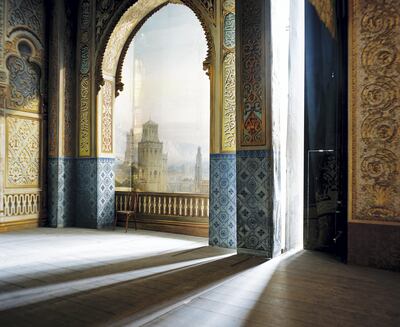
Originally commissioned by the French emperor Napoleon III in the year 1853 to replace an older, 18th-century theatre that was housed in Fontainebleau’s Belle Cheminée wing, the 400-seat auditorium and its four floors of associated reception rooms, foyers, staircases and residences for actors, musicians and stage hands was constructed in an incomplete part of the château, the western half of a wing that had originally been commissioned by Louis XV.
Inspired by Queen Marie Antoinette’s small theatre at the Palace of Versailles and realising the need to impress Napoleon III and the Empress Eugénie, whose linked monograms appear on gilt panels throughout the theatre, the architect Hector Lefuel created a lustrous, jewel-like interior finished with yellow damask wallpaper and upholstered in the finest woollen carpets and delicate silks.
Built at great speed, the theatre was inaugurated with great fanfare in 1857 during a visit from the Grand Duke Konstantin of Russia, brother of Tsar Alexander II, but was only ever used approximately 15 times, after which it was effectively closed and left, like a time capsule, overlooked and gathering dust.
“The theatre was closed in 1868 when the royal court left Fontainebleau,” explained Vincent Cochet, head heritage curator for the Palace of Fontainebleau.
“After that, it was only used once in 1936, and about 10 times during the Second World War. In 1941, it was decided that it was too dangerous to keep the theatre open.
“Everything in the theatre is made of wood and there were only candles to light the space. It has been closed since then.”
Despite the development of plans for the theatre’s restoration in the 1960s and 1980s, it was only in April 2007, just a month after the signing of the intergovernmental agreement between the UAE and France that established the Louvre Abu Dhabi, that sponsorship from the Government of Abu Dhabi allowed these plans to become a reality.
The project now receives an annual renewable grant of €5 million (Dh21.7m) and the theatre was renamed in Sheikh Khalifa’s honour, as a measure of thanks.
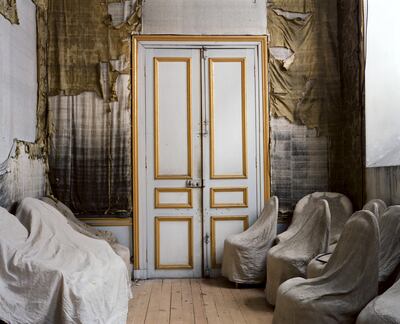
Led by Patrick Ponsot, chief architect of historic monuments for the French government, Vincent Cochet and Jean-Paul Gousset, technical director for the royal Opera at Versailles, the first phase of the theatre’s conservation and restoration, which focused specifically on the auditorium, vestibule and imperial foyer on the second floor, was completed in 2014.
The works included the removal of hazardous asbestos and lead, the reinforcement of the floors and foundations, and the strengthening of the walls and the updating of the lighting in the auditorium.
The milestone was celebrated with an intimate opening ceremony attended by Sheikh Sultan bin Tahnoon Al Nahyan, then chairman of the Abu Dhabi Tourism & Culture Authority (TCA), and Aurélie Filippetti, the French minister for culture and communication, and was accompanied by the first performance to be held in the theatre in more than 70 years.
Now focused on the stage, the back-of-house areas, the scenery, upper foyers and actors’ quarters, the final phase of restoration works began last month, and when they are completed, the theatre will finally be able to be opened to the public in its entirety.
The work not only involves the installation of a heating system that will allow a constant temperature to be maintained in the building – creating an environment more conducive to its conservation – but also includes the installation of fire protection and electrical systems as well as the renovation of its reception rooms, corridors and foyers on the upper floors.
These include the loges grillées, concealed boxes up near the auditorium’s roof, where invited guests could watch performances unseen and unobserved, without the need to dress in a manner befitting a state occasion.
"For us, the goal in restoring this building is to successfully navigate the transition to the modern world, but to do this while appearing to have done nothing," explains Cochet, who predicts that the restoration works will be complete in 2019.
“We have given the theatre the name of the person who is financing its restoration, and for us this a very valuable partnership between this château, which represents all of the kings of France, and the emirate of Abu Dhabi.”
___________________
Read more:
In pictures: Inside the Sheikh Khalifa at the Palace of Fontainebleau
Second phase of UAE’s restoration of French theatre begins
Why my travel broadens other minds
___________________
